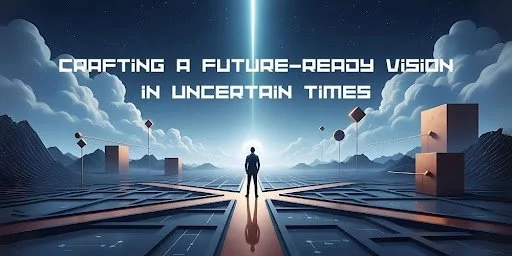Crafting a Future-Ready Vision in Uncertain Times
If there’s one thing leaders can agree on right now, it’s this: the future feels anything but certain. In Episode 75 of Talent Talk, I sat down with Victor Morales, an experienced CEO and purpose-driven strategist, to unpack what it truly means to craft a vision that’s not just inspiring—but adaptable, grounded, and built for an unpredictable world.
🎧 Catch the full episode on Spotify:Talent Talk – Episode 75
Why Your Vision Can’t Be Static Anymore
Gone are the days of setting a 10-year vision and walking away. Today, leaders must create living visions—visions that stretch, flex, and evolve with the world around them.
Victor shared something that really resonated with me:
"If your vision can’t adapt, your organisation won’t either."
He’s right. I see this in my coaching all the time—teams thrive when the vision is clear, yes, but also when it feels real and responsive. Your people need to see how the vision connects to now, not just some distant ideal. When a vision becomes outdated, it becomes irrelevant—and irrelevant visions erode engagement faster than any strategic failure.
And let’s be honest: many leaders cling to vision statements because they look good on a poster. But a poster doesn’t build alignment. A living, breathing, inclusive vision does.
The Balance: Anchored Yet Agile
Victor and I talked about what it looks like to balance clarity with flexibility. A strong vision is rooted in purpose—it should be anchored by your values and your reason for existing. But how do you get there? That should always be up for discussion
In my work, I often ask leaders:
What’s your vision anchored in?
When did you last test it against reality?
Are you willing to revise it if needed?
One of the best examples I’ve seen of this was during a session with a leadership team in a global tech company. Their original vision focused solely on product growth. But as we unpacked their recent experiences, it became clear. Their real driver was impact—how their work affected people, not just profits. That shift unlocked an entirely new level of team energy and commitment.
Being future-ready means being willing to pivot, without losing your why.
How to Create a Vision That Lives and Breathes
Here are four key steps Victor and I both use when helping leaders shape powerful, adaptive visions:
1. Start with Purpose, Not Profit
A great vision begins with why you exist, not just what you do. People don’t rally behind numbers—they rally behind meaning. When your vision speaks to something bigger than the bottom line, it becomes magnetic.
2. Make It Collective
Involve your people. Co-create. The more your team helps shape the vision, the more they’ll own it. Ask for their stories, their aspirations, and their perspectives. That’s how you build buy-in.
3. Stay Context-Aware
Scan your environment regularly. What’s changed? What assumptions no longer hold? Visions should adapt to the world around them. This doesn’t mean rewriting your purpose every quarter—it means staying responsive.
4. Build Feedback Loops
Test it. Sense-check it. Revisit it. Victor and I both believe that reflection is where insight lives. Vision is not a once-a-year event—it’s a continual dialogue.
The Emotional Impact of Vision
This part of the episode hit close to home for me: we often talk about vision as a strategic tool, but it’s also deeply emotional. A strong vision gives people something to believe in. It reconnects them to purpose when things get hard.
"Your team needs to feel the future," Victor said.
And I couldn’t agree more. In moments of uncertainty, your vision becomes the heartbeat of your organisation. It helps people make sense of chaos. It anchors them in what matters.
I’ve worked with leaders navigating redundancies, restructures, and massive change. In every case, the teams that stayed grounded were the ones that knew where they were going—and why. Even if the “how” kept shifting, their north star didn’t.
A Personal Reflection
Working with leaders across industries, I’ve noticed that the most resilient teams aren’t the ones with the best tech or even the best talent. They’re the ones with a shared sense of purpose. They know what they’re moving toward—and why it matters.
That’s what Victor and I explored in this conversation: how to reconnect leadership to meaning, even when the path ahead isn’t clear.
I often invite leadership teams to revisit the stories that shaped them—the wins, the losses, the learnings. That collective reflection often reveals a deeper, more authentic version of the vision than anything found in a strategy deck.
And here’s something else: a powerful vision doesn’t just inspire teams. It attracts the right partners, customers, and talent. In a world where everyone’s looking for alignment, your vision is your differentiator.
Final Thoughts
If you’re leading a team right now, I invite you to revisit your vision. Ask yourself:
Does it still fit who we are and what the world needs?
Have we made space for our people to shape it with us?
Are we treating vision as a tool for alignment—or as wallpaper?
The future will remain uncertain. But your leadership doesn’t have to. Craft a vision that can evolve, include, and inspire. And then let it breathe.
Go Deeper with Talent Talk
This blog is part of a 5-part series based on Episode 75 of Talent Talk with Victor Morales. Listen to the full episode on Spotify to hear our full conversation on future-focused leadership.
📣 Want support crafting a clearer, more human vision with your team? Visit The Career Establishment to explore leadership coaching, workshops, and more.

